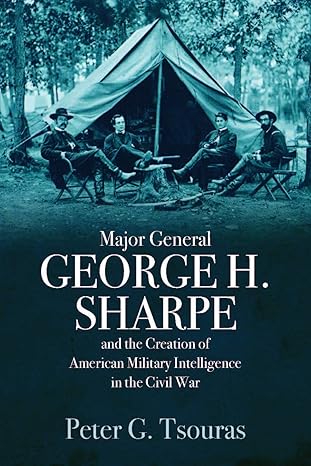Special Order 191: Ruse Of War
By Joseph Ryan
Introduction
On September 5, 1862, General Lee crossed his army over the Potomac into Western Maryland. It had taken him four months to maneuver Lincoln's armies out of Virginia and the effort had left his soldiers decimated and the survivors staggering. He needed to get them into the Shenandoah Valley, the only place within a radius of sixty miles from his position, after the fierce battle at Manassas, where they could find subsistence, rest, and reorganize. But, in turning his army back from the environs of Washington, it was impossible for him to lead it directly across the Blue Ridge into the Valley. Lincoln's armies would consolidate under McClellan's command again and would either follow him or move toward Richmond, and he would have to hurry his soldiers across the wasteland of Northern Virginia to intercept them. Only one strategy would keep the enemy away from Richmond and that was to march to the Valley indirectly, through Maryland.
Twelve days after General Lee's army entered Maryland, the Battle of Antietam was fought on Constitution Day. In the space of twelve hours, over five thousand young Americans lost their lives in action and another twenty thousand were wounded. Soon after, General Lee's soldiers were safely in the Shenandoah Valley, camped along the Opequon unmolested, where they remained until the end of October.
Since the end of the Civil War, generations of historians, as well as popular Civil War writers, have pushed the view that the Battle of Antietam happened by accident, that in entering Maryland General Lee had planned to carry the war into Pennsylvania, drawing McClellan after him, but someone—perhaps one of General Lee's division commanders, D.H. Hill—had negligently lost a copy of Lee's movement order, which allowed McClellan to thwart Lee's plans and force him into battle at Sharpsburg.
How the objective truth of history was so easily obscured, is an easy story to tell: first, the percipient witnesses─General Lee, himself, as well as his personal staff and the general officers closest to him - lied to the public, though not to his President; second, the contemporary chroniclers, led astray by the official reports and the writings of the officers, incorporated the lies into the first generation’s version of events, and this version has been repeated by successive generations of historians as the truth of history.[1] Now, weighed down by the mountainous mass of civil war literature it is impossible for the serious student, coming fresh to the matter, to shed the waste and start again at the beginning and dig into the objective details to reconstruct what actually happened at Frederick, Maryland, when General Lee arrived there in September 1862.
There are many myths masquerading as civil war history, simple ones such as Barbara Fritchie’s encounter with Stonewall, or the story of Solomon Northrup’s oppressive captivity in antebellum Louisiana, or the cause of the scars shown on Poor Peter’s back─the image of which emotional politicians wave about in congressional sessions as proof of the horror of slavery as it was in the nation’s antebellum time. But, unlike those simple stories, the myth of how the Battle of Antietam came to happen is mired in dissemblance and complexity: it would take a six week trial in court to expose the deception lying at the core of it─the explanation the historians offer the public how it happened Special Order 191 was lost.
I. D.H. Hill Defends Himself
 The public story begins in 1867, when the editor of the Richmond Examiner, E.A. Pollard, published a book entitled, The Lost Cause .[2] In it, Pollard claimed that the loss of General Lee's movement order—Special Order 191 found by a Union soldier in a field at Frederick Maryland on September 13, 1862—happened because Confederate Major General Daniel Harvey Hill, "in a moment of passion had thrown the paper to the ground."[3] Incensed by Pollard’s slur on his military reputation, D.H. Hill published, in a popular magazine called The Land We Love, in February 1868, an article entitled The Lost Dispatch.[4] In his article, Hill categorically denied having anything to do with the loss of Special Order 191. In support of his denial, he offered the fact that he had in his possession a copy of the subject order, written in Stonewall Jackson's hand.[5] Jackson, Hill wrote, "did not trust it to be copied by his adjutant, and with care, I carried it in my pocket and did not trust it among my office papers."[6]
The public story begins in 1867, when the editor of the Richmond Examiner, E.A. Pollard, published a book entitled, The Lost Cause .[2] In it, Pollard claimed that the loss of General Lee's movement order—Special Order 191 found by a Union soldier in a field at Frederick Maryland on September 13, 1862—happened because Confederate Major General Daniel Harvey Hill, "in a moment of passion had thrown the paper to the ground."[3] Incensed by Pollard’s slur on his military reputation, D.H. Hill published, in a popular magazine called The Land We Love, in February 1868, an article entitled The Lost Dispatch.[4] In his article, Hill categorically denied having anything to do with the loss of Special Order 191. In support of his denial, he offered the fact that he had in his possession a copy of the subject order, written in Stonewall Jackson's hand.[5] Jackson, Hill wrote, "did not trust it to be copied by his adjutant, and with care, I carried it in my pocket and did not trust it among my office papers."[6]
Rejecting Pollard's supposition that General Lee's headquarters staff had prepared a copy of Special Order 191 for his attention, sending it to his camp by courier, Hill offered the affidavit of his adjutant, William Ratchford, in which Ratchford swore no such order arrived at Hill's headquarters.[7] In support of Ratchford’s statement, Hill offered the fact that, upon crossing the Potomac into Maryland at Cheek's Ford, his division advanced to Frederick under Jackson's command; as a consequence, Hill wrote, "we drew all of our supplies and received all our orders for the next several days through Jackson." Under such circumstance, Hill explained, "Official etiquette required [Special Order 191] to be sent to me through Jackson."[8] "It [is] utterly incomprehensible that all orders should come through the proper channels, except this one, the most important of all," he wrote.
Having rebutted Pollard's charge that he was responsible for the loss of Lee's order, Hill went on to explain how the finding of the order induced McClellan to act in a manner beneficial to Lee. The text of the order specified that, as of September 13th, the “main body” of the Confederate Army, with all its supply, artillery, and ammunition trains, would be waiting behind South Mountain at Boonesboro for the detached commands of Jackson, Walker, and McLaws to return the the main body from their operations.[9] Yet, in fact, on September 13th, the only rebel infantry force occupying Boonesboro was D.H. Hill's lone division of five brigades. Preceding the march of Hill's division to the South Mountain, General Lee, in the company of Longstreet's command,[10] had camped at Boonesboro the night of September 10th as the order specified; but, on the following morning, he had gone with Longstreet's command to Hagerstown, thirteen miles to the northwest, ostensibly to gain possession of the town's supplies. The army's trains accompanied the march of these troops, and, reaching the vicinity of Hagerstown, the reserve artillery and ammunition trains, with much of the supply trains, were turned on to the roads leading to Williamsport and, by September 13th, they were crossing the Potomac, moving around toward Sheperdstown.[11]
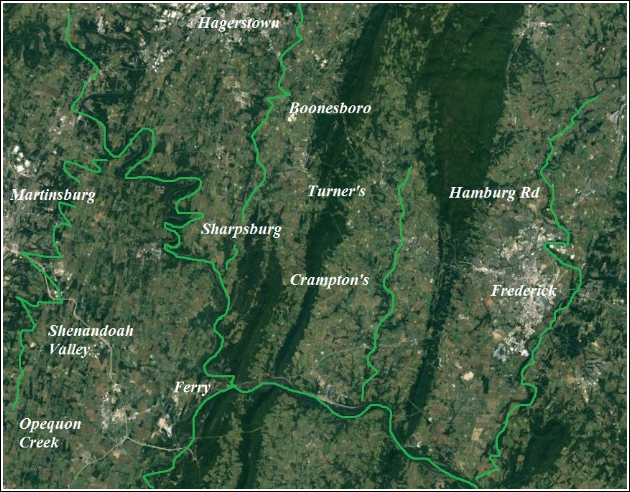
When McClellan read the Lost Order, he naturally assumed that he would encounter a dangerously strong body of Lee’s troops as he passed over South Mountain. As a consequence of this thinking, he delayed attacking in earnest the position D.H.Hill's division was defending—Turner's Gap on the road to Boonesboro—until he had concentrated almost four of his five corps in front of the mountain pass. "McClellan could have crushed my little squad in ten minutes but for the caution inspired in him by the belief that [Lee's main body] was there," Hill wrote.[12] After reading the Lost Order, McClellan had another good reason to cautiously approach the South Mountain, Hill offered—he had to worry that Jackson had returned from Martinsburg, where Lee's lost order specified he was sent, and was lurking somewhere on the other side of the mountain.[13]
On both these points, D.H. Hill's position is plainly correct. The text of Special Order 191 unambiguously specifies that Longstreet's command, with the army trains, was to camp at Boonesboro, and that Stonewall Jackson's command was to cross the Potomac and "take possession of the Baltimore & Ohio Railroad at Martinsburg capturing the garrison there," and then return to Maryland to join Lee's "main body," either at Boonesboro or Hagerstown.[14] As Hill put it in The Lost Dispatch, "the apprehension that [Jackson] had returned from Martinsburg, as directed by Lee's order, and which he had time to do, made McClellan still more guarded in his approaches."[15]
II. General Lee Rejects Hill’s Claim
At the time The Lost Dispatch was published, D. H. Hill sent a copy to General Lee, who was then acting as President of Washington College in Lexington, Virginia.[16] Lee soon found himself drawn into conversation about Hill's article with various persons connected to the college faculty.[17] After these conversations occurred, Lee wrote a personal letter to D.H. Hill, on February 21, 1868.[18] In his letter, professing to have no knowledge of how the order was lost,[19] General Lee rejected Hill’s position that the Army’s custom and practice did not require Lee's headquarters staff to send a copy of the order directly to D.H. Hill. Lee wrote, without offering any objective basis—"[I]t was proper in my opinion that a copy of the order should be sent to you by the adjt General."[20]

In his piece Hill had written in italics: "In going to Harper's Ferry from Martinsburg instead of returning to Boonesboro, Jackson acted on his own responsibility and in violation of Lee's order."[21] To this, General Lee replied that Jackson was "by verbal instructions" placed in command of the expedition "to dislodge the Federal troops occupying Martinsburg and Harper's Ferry."[22] As verification of his statement, General Lee offered a quotation from Jackson's official report of his operations: "In obedience to instructions from the Commg Genl, and for the purpose of capturing the Federal forces and stores then at Martinsburg and Harper's Ferry, my command left the vicinity of Frederick City on the 10th".[23] Lee’s response, though, ignores the plain text of the order. No doubt Jackson did receive verbal instructions from General Lee to go to Harper's Ferry—at the time they were known to have conferred together in private[24]—but the indisputable fact remains that Jackson was in possession of a written order (albeit in his own hand) which specified that he march his command to Martinsburg, not to Harper's Ferry.[25] And, indisputably, a penciled copy of that particular order came into George McClellan's possession.[26]
General Lee claimed in his letter to Hill that the loss of the order was "a great calamity" to his campaign, writing that he had "supposed there would have been time for [the execution of Jackson's verbal orders] and for the army to have been reunited before Genl. McClellan could cross the South Mountains."[27]
Why did he suppose this? His letter offers as his reason that "Genl. Stuart who was on the line of the Monocacy reported that Genl McClellan had reached Rockville and was advancing very slowly with an extended front, covering the roads to Washington and Baltimore." But the question, as Hill saw it, was not how slow McClellan was moving before he read the lost order, but how slow he was moving after he read it. What possible basis did General Lee possess to think McClellan's advance from Frederick would be so slow that Harper's Ferry could be overrun (or the garrison induced to surrender), and Lee's detached columns reconcentrated in Maryland before McClellan's army came into the Cumberland Valley? Lee's letter to Hill does not say.
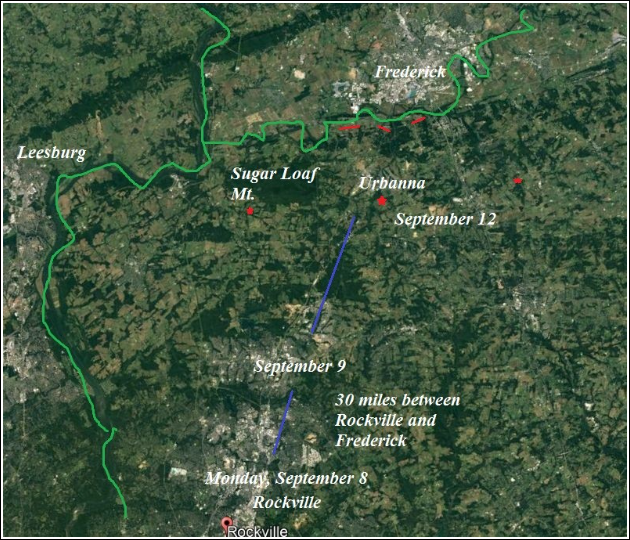
Against Lee’s claim that he supposed he would have time to reconcentrate before McClellan engaged him, must be put what Lee knew on September 9. On September 9th, at Frederick, he was informed by Stuart that McClellan's army was beginning to march westward from Rockville on a broad front. The right wing under Burnside's command—Reno's and Hooker's corps—marching on the National Road so as to block an enemy advance that might materialize in the direction of Baltimore. McClellan's left wing, composed of Franklin's corps, supported by Couch's division, was marching west on the roads close to the Potomac so as to block an enemy advance in the direction of Washington. And his center, composed of Sumner's corps, the 12th corps, and Fitz John Porter's corps, was marching on the Georgetown turnpike leading to Urbana and Frederick.
From this, a reasonable person in Lee’s shoes would know that McClellan was expecting to be attacked as the front of his army advanced and, in consequence, would move forward cautiously, especially given his experience with Lee on the Peninsula. But once McClellan reached Frederick and found that the enemy was retreating instead of advancing, Lee could expect that McClellan’s defensive-minded advance would shift to an offensive-minded one, the velocity of the march accelerating. For, to the mind of any competent general in McClellan’s shoes ─ and McClellan was competent ─ an enemy in flight poses hardly the same threat as an enemy operating on the offensive.[28]
Given the depleted ranks of his army and the sorry condition of his supplies, General Lee, even as aggressive a soldier as he was, must have known he could not avoid retreating from Frederick. To make a stand on the line of the Monocacy, he would have needed twice, if not three times, the strength he possessed. To keep McClellan's vast array out of his rear, he would have had to extend his front to cover the National Road on his left and the mouth of the Monocacy on his right—a length of front entirely beyond the capacity of his little army to achieve.
Knowing, then, that retreat from Frederick was mandatory, but that he had to fight a battle with McClellan somewhere, in the trial court we may reasonably assume that General Lee must have canvased his map, probably in the company of Jackson, looking for an available location in Maryland where natural barriers would make the turning of his flanks impossible. Plainly, he saw that that place was behind the Antietam at Sharpsburg—where he would have only a three mile front to defend, the shoulders of which would be pressed against the folds of the Potomac. But to fight a general battle in this position, the rebel army required a secure line of retreat to Winchester, in the Shenandoah Valley, and the Union garrison at Harper's Ferry—10,000 soldiers and 1,200 cavalrymen—posed an unacceptable threat to it.
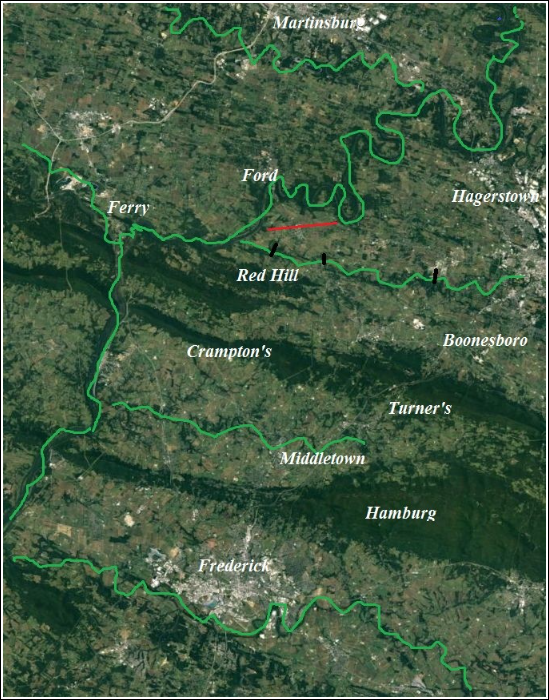
For this reason, General Lee gave Jackson verbal instructions to capture Harper's Ferry and rejoin the rest of the army in Maryland. Making the decision to send Jackson however, to neutralize the Martinsburg and Harper's Ferry garrisons, did not solve the problem created by the direction the Union Army's advance would take, once word reached McClellan that the enemy was retreating. Once McClellan reached Frederick and found it abandoned by the enemy, he would certainly learn that the enemy had crossed the Potomac into Virginia and this fact would induce him to rush his army directly toward Harper's Ferry in order to get a powerful force quickly into the Shenandoah Valley, to pursue or break up the enemy's retreat in the direction of Winchester.[29] The three rebel divisions remaining with Lee behind South Mountain—D.R. Jones's, John Hood's, and D.H. Hill's—could hardly be expected to paralyze the advance of McClellan's five corps toward Harper's Ferry. Something else was required to have any chance of doing that. All of this General Lee ignores in his letter to Hill.
Lee's letter does offer an argument of sorts for the proposition that McClellan's reaction to reading the lost order placed the Confederate Army in grave peril.[30] The letter quotes a message McClellan had written to William Franklin at 6:20 p.m., on September 13th (Franklin was then encamped at Buckystown.); but McClellan's message proves, not disproves, Hill's case that reading the lost order induced him to do exactly the opposite of what he would have done if the order had not been found.
McClellan wrote Franklin: "I have now full information as to movements and intentions of the enemy. Jackson has crossed the Upper Potomac to capture the garrison at Martinsburg, and cut off Miles's retreat towards the west. A division on the south side of the Potomac (Walker's) was to carry Loudoun Heights, and cut off his retreat in that direction. McLaws, with his own division and the division of R.H. Anderson, was to move by Boonesboro and Rohrersville to carry Maryland Heights. . . . Longstreet was to move to Boonesboro, and there halt with the reserve trains, D.H. Hill to form the rear guard, Stuart's cavalry to bring up stragglers etc."[31]
Clearly, George McClellan could read Lee's English correctly; as a result, he formulated a plan of action which placed his main body in front of where Lee's lost order placed the Confederate “main body.”[32] But while his main body was composed of thirty brigades he did not know that Lee's was composed of only fourteen.[33] Thinking Lee and Jackson intended to attack him from the direction of Boonesboro, McClellan assigned but three divisions to advance against the two rebel divisions, under McLaws's command, which had marched to Maryland Heights, ostensibly "to endeavor to capture Harper's Ferry."[34] The rest he massed in front of Turner’s Gap.
III. General McClellan Reacts to the Perceived Circumstances
Direction, not speed, is the key to understanding Lee's ruse with the lost order. If he had not read the lost order, a reasonable general in McClellan's circumstances would have directed his main body on Rohrersville, instead of Boonesboro, with the plan of relieving Miles at Harper's Ferry and then pressing after the enemy wherever found. Through the 11th and 12th McClellan had received many reports that told him the enemy was apparently making a headlong retreat across the river: From Harper's Ferry, Colonel Miles telegraphed that a heavy column of troops was passing through the Cumberland Valley in the direction of Hagerstown;[35] from Pennsylvania Governor Andrew Curtin came the advice that "Jackson is crossing at Williamsport and probably the whole army will be drawn from Maryland."[36] Even Lincoln, wiring McClellan that the enemy was crossing the Potomac, pleaded with McClellan at the time—"Please do not let him get off without being hurt."[37]
In reaction to these reports, on the 12th at 5:30 p.m., McClellan wired Lincoln's general-in-chief, Henry Halleck, "My columns are pushing on rapidly to Frederick. From all I gather, secesh is skedalleling, and I don't think I can catch him unless he is really moving into Pennsylvania. . .[38] I begin to think he is making off to get out of the scrape by recrossing the river at Williamsport. . . I shall endeavor to cut off his retreat. My movements tomorrow will be dependent upon information received during the night."[39] By this time, the advance guard of McClellan's right wing had entered Frederick.
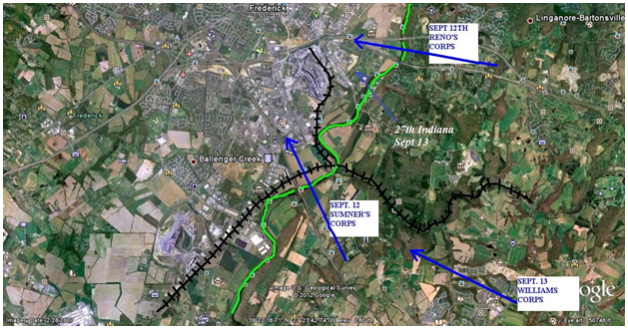
 Under the circumstances known to McClellan the evening of the 12th, there was only one way his army could possibly have caught the enemy in retreat: Its main body—at least three, if not four, of its five corps—must march on the morrow in the direction of Crampton's Gap in the South Mountain, pass into the narrow enclave called Pleasant Valley and move in the direction of the Potomac; the remainder of the army to march west on the National Road to guard the main body's right flank and rear from possible attack coming from the direction of Turner's Gap, six miles to the north of Crampton's. Once on the Virginia side of the river, McClellan's columns would then march into the Shenandoah Valley and converge on the enemy's line of retreat toward Winchester, with the rear guard of the army, passing Turner's Gap into the Cumberland Valley, closing up by passing the Potomac at Shepherdstown.
Under the circumstances known to McClellan the evening of the 12th, there was only one way his army could possibly have caught the enemy in retreat: Its main body—at least three, if not four, of its five corps—must march on the morrow in the direction of Crampton's Gap in the South Mountain, pass into the narrow enclave called Pleasant Valley and move in the direction of the Potomac; the remainder of the army to march west on the National Road to guard the main body's right flank and rear from possible attack coming from the direction of Turner's Gap, six miles to the north of Crampton's. Once on the Virginia side of the river, McClellan's columns would then march into the Shenandoah Valley and converge on the enemy's line of retreat toward Winchester, with the rear guard of the army, passing Turner's Gap into the Cumberland Valley, closing up by passing the Potomac at Shepherdstown.
On the 13th, however, having reached Frederick and read Lee's lost order, McClellan did exactly the opposite of this. As General Lee's letter to Hill only partially quotes, he messaged to Franklin, at 6:20 p.m., "The whole of Burnside's command march. . . followed by Sumner, the 12th Corps and Sykes (division of Porter's corps) upon Boonesboro to carry that position. . . . Without waiting for the whole of [Couch's] division to join you, you will move at day-break by Jefferson and Burkittsville upon the road to Rohrersville. . . in order to cut off the retreat of or destroy McLaws's command. . . If you effect this. . .[40] you will then return to Boonesboro if the main column has not succeeded in its attack. If it has succeeded, take the road to Sharpsburg and Williamsport, in order to cut off the retreat of Hill and Longstreet towards the Potomac, or to prevent the repassage of Jackson. My general idea is to cut the enemy in two."[41]
But for his choice of deployment, George McClellan might have achieved his objective of cutting the enemy in two. Instead, by late evening on the 14th, he found himself only in possession of the South Mountain gaps, and the next morning—Harper's Ferry having amazingly been surrendered [42] —his main body took possession of Boonesboro and cautiously began to follow the enemy toward Sharpsburg. Induced by Lee's lost order not only to direct the weight of his forces away from Crampton's Gap—the gateway to Pleasant Valley and the Potomac crossing at Harper's Ferry—but also to delay launching an overpowering attack on D.H. Hill's position at Turner's Gap, McClellan had given Lee time to clear his rear of the enemy and concentrate for battle behind the Antietam. Time Lee would not have had, but for the lost order.
IV. How Lee's Order Was "Lost."
According to the historical evidence, sometime close to noon on September 13, 1862, a Union soldier, Private (perhaps Corporal) Barton Mitchell of the 27th Indiana Regiment, Gordon's Brigade, 12th Corps, was engaged in stacking arms with his comrades at Frederick, when he discovered Lee's lost order lying on the ground.[43] The first public description of this occurrence was given by Silas Colgrove, the 27th Indiana's war time colonel, to the editors of the Century Magazine, in 1886.[44] Colgrove wrote: "Within a few minutes of halting, the order was brought to me by First Sergeant John M. Bloss and Private B.W. Mitchell, of Company F, who stated that it was found by Private Mitchell near where they stacked arms. When I received the order it was wrapped around three cigars, and Private Mitchell stated that it was in that condition when found by him."[45]
According to his letter to the Century editors, Colgrove carried the found order directly to the headquarters of the 12th Corps' temporary commander, Alpheus S. Williams, and handed it to Williams's adjutant, Colonel Samuel E. Pittman. Pittman showed it to Williams who signed a message to McClellan—"I enclose a special order. . . which was found on the field. . . It is a document of interest."[46] By Williams's choice of language, one may reasonably assume his message to McClellan, along with the found order, was placed in an envelope. Pittman then had a courier carry the documents to McClellan's headquarters and hand them to McClellan's adjutant, Seth Williams.[47] When Lee's lost order was handed to McClellan he reportedly exclaimed in the presence of civilians—"Now I know what to do."[48]
How General Lee's order was lost has been most often explained as happening by accident; as the romantic civil war writer, Stephen W. Sears, most recently put it: "Far and away the most likely explanation for the loss of order 191 is also the simplest—that it was accidentally dropped by a courier from Lee's headquarters while on his way to deliver it to D.H. Hill."[49] However, when the totality of the available evidence is marshaled, it is impossible to ignore the greater probability that Special Order 191 was intentionally lost by General Lee, in order to induce McClellan to throw the weight of his army against South Mountain's Turner's Gap instead of Crampton's.
Besides the practical situation General Lee's army was in, the relevant circumstances that establish the probable truth of the matter are these: staff procedure, the cigars, weather, the stationer's stamp, Lee's reaction to notice of the order's loss, and, finally, the seemingly unsolvable issue of identifying the writer of McClellan's copy. From the convincing force of these facts the conclusion necessarily follows that it is more likely than not true that the order was dropped near Private Barton Mitchell's side, by a civilian passing casually by as Mitchell and his comrades of the 27th Indiana Regiment were stacking arms.
A. Staff Procedure
The officers whose positions placed them at General Lee's headquarters during the Antietam Campaign fall into three distinct categories: the general staff of the army, General Lee's personal staff, and those officers attached to his headquarters as field agents of the Adjutant General's Office at Richmond. The members of Lee's general staff—the chiefs of the various departments of his army such as artillery, commissary, quartermaster etc—were not involved in the preparation, record keeping and transmission of movement orders addressed to commanders of infantry units. The members of Lee's personal staff and that of the Adjutant General's attached staff had mixed involvement with the promulgation of such orders. The names of the officers who composed Lee's personal staff at the time are in order of descending rank: A.L. Long, Lee's military secretary, Walter Taylor, aide and sometime adjutant, and aides T.M.R. Talcott, Charles Marshall and Charles A. Venable. The members of the attached Adjutant General's staff were Robert Chilton, Assistant Adjutant General, and his aide, A.P. Mason.
The Regulations for the Army of the Confederate States specify the following with regard to "special orders." Such orders "relate to the march of some particular corps" and "are not published to the whole command." An "important special order must be read and approved by the officer whose order it is, before it is issued by a staff officer." Such orders are generally put "through the office of the Adjutant or Adjutant and Inspector General of the Command" and they "are transmitted through all intermediate commanders in the order of rank." In contrast to "special" orders, "general" orders "announce. . . whatever may be important to make known to the whole command."[50] "During marches and active operations, all orders will be either sent direct to the troops, or the respective commanders will be informed when to send to headquarters for them." "Copies of all orders of the commanders of armies. . . will be forwarded at their dates, or as soon thereafter as practicable, in separate series, on full sheets of letter paper to the Adjutant and Inspector General's (General Samuel E. Cooper's) office" in Richmond."[51]
In the case of Lee's lost order, conformance with the substance of the regulations quoted above was accomplished by General Lee's personal and attached staff officers in the following manner. First, on September 9th, A.P. Mason wrote in his hand a document that he entitled "Special Order 191," which contains the first two paragraphs of the eventual full text of Special Order 191. This two paragraph document contains the actual signature of Robert H. Chilton and was addressed to the Adjutant General's office in Richmond.[52] The obvious function of this document was to establish the fact that, on September 9th, General Lee had ordered his closest aide, Walter Taylor─the aide ordinarily responsible for supervising the creation and dissemination of such orders─to leave the army and travel to Virginia. Taylor was detached from the Army, ostensibly on a mission to persuade President Davis, who was then at Gordonsville attempting to come up to the army, to go back to Richmond.[53]
Second, at some unverifiable moment in time, A.P. Mason wrote the complete official record copy of Special Order 191—the full text is ten paragraphs—into Robert Chilton's bound letter book. At the signature line of this document, A.P. Mason wrote "Adjutant General."[54]
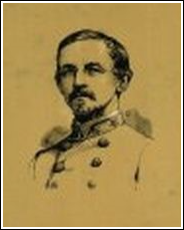 Last, someone, probably Charles Marshall, beginning with the third paragraph, wrote a copy of Special Order 191 in ink. However, for some reason, Marshall labeled it “Special Order 190.” This document is plainly signed by Robert H. Chilton. It was thereafter enclosed with a letter, written in Marshall's hand, dated September 12th, and addressed by General Lee to President Davis. It was delivered by courier to Davis. When Davis fled Richmond in 1865, the letter and enclosure traveled with him to Georgia where it was left for some time in a trunk.[55] These three documents—A.P. Mason's two paragraph copy, the eight paragraph ink-pen copy sent to Davis (Marshall labeled the copy he wrote as Special Order 190), and Chilton's letterbook copy—constitute the only known copies of Special Order 191 created by the ordinary procedures of either General Lee's personal staff or the Adjutant General's attached staff.
Last, someone, probably Charles Marshall, beginning with the third paragraph, wrote a copy of Special Order 191 in ink. However, for some reason, Marshall labeled it “Special Order 190.” This document is plainly signed by Robert H. Chilton. It was thereafter enclosed with a letter, written in Marshall's hand, dated September 12th, and addressed by General Lee to President Davis. It was delivered by courier to Davis. When Davis fled Richmond in 1865, the letter and enclosure traveled with him to Georgia where it was left for some time in a trunk.[55] These three documents—A.P. Mason's two paragraph copy, the eight paragraph ink-pen copy sent to Davis (Marshall labeled the copy he wrote as Special Order 190), and Chilton's letterbook copy—constitute the only known copies of Special Order 191 created by the ordinary procedures of either General Lee's personal staff or the Adjutant General's attached staff.
There is little credible evidence that any copy of Special Order 191 [56] was delivered to the subordinate commanders who supposedly received it—Longstreet, Jackson, McLaws, Walker and D.H. Hill. Longstreet's chief of staff, Moxley Sorrel, wrote, "[The order] was so full that when a copy came in my possession I wondered what could be done with it in event of my falling into the enemy's hands."[57] Longstreet, in an article published in 1886, in the Century Magazine, said about the lost order only this—"Ordinarily, upon getting possession of such an order, the adversary would take it as a ruse de guerre, but it seems that General McClellan gave it his confidence."[58] In his autobiography published in 1896, Longstreet added this, "The copy sent to me was carefully read, then used as some persons use a little cut of tobacco, to be assured that others could not have the benefit of its contents."[59]
John Walker, whose division by the order was sent to Loudoun Heights, wrote, in an article in the Century Magazine,[60] that he received verbal orders while at Frederick on the 9th, "to return to the mouth of the Monocacy and destroy the aqueduct of the Chesapeake & Ohio Canal. . . Retracing our steps toward the Potomac, at 10:00 p.m. of the 9th my division arrived at the aqueduct [and] about 3:00 a.m. on the 10th went into bivouac about two miles west of the Monocacy. Late in the afternoon a courier from General Lee delivered me a copy of [order 191] directing me to cooperate with Jackson and McLaws in the capture of Harper's Ferry."
Finally, of the four commanders, only Lafayette McLaws makes reference in his official report to Special Order 191, saying merely that he moved his command "in compliance" with its requirements.[61] From these meager snippets of unsworn testimony, which constitute all that exists in the record, it is a strain to draw more from them than that communications were transmitted which gave to each commander an understanding of the role he was to play in the movement about to commence. And two of the four, Longstreet and Jackson, received their instructions from Lee directly.
As for Lee's staff officers, they tell us nothing about their personal involvement in the creation and transmission of Special Order 191 to the field commanders. They all claim ignorance of how the order was created, who created it, or how it was received by the field commanders.[62]
The evidence shows that, of the officers on Lee's personal staff, Charles Marshall wrote most of Lee’s letters while at Frederick and Hagerstown. After the war, Marshall made frequent public appearances where he gave addresses on the subject of General Lee's operations, and he prepared a manuscript which, after his death, became a published book in 1927. Yet he never said or wrote anything which revealed his direct knowledge about the matter.
In a letter sent to D.H. Hill, in November 1867, Marshall wrote, "How the order was lost I am wholly unable to conjecture. . . I can only say that the army then not being organized into corps, it was a frequent occurrence to communicate general orders for movements of the whole army to division commanders. . . Such orders were usually copied by the staff, one getting copied into the Confidential Book, to be copied into the general order book post factum.[63] They were sent out by orderlies who were required in cases of moment to bring back envelopes or some other receipt from the officers to whom they were sent."[64] In Marshall's manuscript, published as a book twenty years after his death by British major general, Frederick Maurice, we are offered only this snippet: ". . . as yet unexplained, a copy of the general order directing movement of the whole army. . . fell into the hands of General McClellan."[65] Telling us that a custom existed, in the creation and transmission of orders, tells us nothing we don't already know from reading the Confederate Army's Regulations concerning the promulgation of orders.[66] Marshall tells us nothing about who, among Lee's staff officers, actually supervised the recording and transmission of the order to the field.[67]
Frederick Maurice became the editor of Marshall's manuscript, in 1927, because he had two years before published a book about General Lee.[68] Reading Maurice's book about Lee, Marshall's eldest son, a New York lawyer named H. Snowdon Marshall, wrote to Maurice in England and offered his father's manuscript. In his letter Marshall's son said: "When I read your book I heard my father talking again, and it seems to me that you divined a trait in General Lee, which had a tendency to obscure the truth of history. . . I am almost bewildered at the startling accuracy with which you found your path through this camouflage of suppression of actual facts. I think [my father] had in mind the feeling that to print indisputable facts which had been edited out of the reports by General Lee would be a disloyalty."[69] Clearly, if any one besides Taylor would have known who supervised the transmission of Special Order 191 to the field, it was Charles Marshall. Yet, the language he used in his letter to D.H. Hill makes plain he did not know that person's identity.
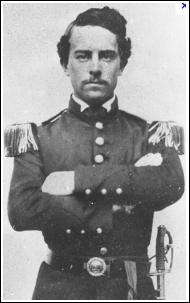 The other staff officers, too, refused to reveal who was responsible. Walter Taylor, who most certainly would have known, had Lee not ordered him away from Frederick on the 9th, published two books in his life time. In the first, published in 1878, he wrote, "It was the custom to send copies of such orders, to the commanders of separate corps or divisions only."[70] "It is impossible to explain how a copy addressed to D.H. Hill was thus carelessly handled or lost."[71] In a footnote, though, Taylor pointed the finger at Charles Venable, writing—Venable always contended "One copy was sent directly to Hill from headquarters."[72] A.L. Long, writing in his biography of Lee, in 1886, repeated this same one line quotation which he attributed to Venable.[73] For Charles Venable's part, nothing can be found in the historical record that acknowledges this hearsay testimony as his own.[74]
The other staff officers, too, refused to reveal who was responsible. Walter Taylor, who most certainly would have known, had Lee not ordered him away from Frederick on the 9th, published two books in his life time. In the first, published in 1878, he wrote, "It was the custom to send copies of such orders, to the commanders of separate corps or divisions only."[70] "It is impossible to explain how a copy addressed to D.H. Hill was thus carelessly handled or lost."[71] In a footnote, though, Taylor pointed the finger at Charles Venable, writing—Venable always contended "One copy was sent directly to Hill from headquarters."[72] A.L. Long, writing in his biography of Lee, in 1886, repeated this same one line quotation which he attributed to Venable.[73] For Charles Venable's part, nothing can be found in the historical record that acknowledges this hearsay testimony as his own.[74]
 As for Robert Chilton, who signed the two copies of the order that were transmitted to Richmond, he offers, unknowingly or not, information that reveals the probable truth of the situation. In 1874, in writing a reply to an inquiring letter received from Jefferson Davis, he wrote speaking of Hill: "Not having as I have told you kept a journal, I could but give my recollection, viz. that they were sent to all division commanders, entrusted with special duties, his at the Monocacy, that couriers were required to bring back envelopes or other evidences of delivery, failure in doing this to lead to a duplicate order to ensure its receipt. . . but I could not of course say positively that I had sent any particular courier to him after such a lapse of time."[75]
As for Robert Chilton, who signed the two copies of the order that were transmitted to Richmond, he offers, unknowingly or not, information that reveals the probable truth of the situation. In 1874, in writing a reply to an inquiring letter received from Jefferson Davis, he wrote speaking of Hill: "Not having as I have told you kept a journal, I could but give my recollection, viz. that they were sent to all division commanders, entrusted with special duties, his at the Monocacy, that couriers were required to bring back envelopes or other evidences of delivery, failure in doing this to lead to a duplicate order to ensure its receipt. . . but I could not of course say positively that I had sent any particular courier to him after such a lapse of time."[75]
Chilton's statement does speak to his knowledge of a courier being sent with the order to Hill, but he puts Hill at the Monocacy when, in fact, it was John Walker who was at the Monocacy and Walker acknowledges the receipt of his marching orders by courier. Twelve years after the event, it seems obvious that Chilton had apparently confused Hill with Walker.[76] Corroborating this is the evidence which shows General Lee was prone to give verbal instructions directly to his subordinate commanders—he admits this, Longstreet and Walker directly confirm it—and, thus, it is reasonable to conclude that Walker, as the only officer of the five officers involved to be actually detached from the main body of the army on the 9th, should have received his marching orders by courier.
What can reasonably be deduced, therefore, from the known evidence of General Lee's staff procedure, is that two copies, each containing partial text of what would be preserved in Chilton’s letter book as “Special Order 191,” were written in pen─one by Marshall, the other by Mason─and that Robert H. Chilton signed his name to them. Despite the fact that one or more of Lee’s staff officers should have known whether a copy of the general movement part of the order was actually sent to D.H. Hill's headquarters [77] from Lee’s, they offer us nothing which reasonably can be relied on as evidence establishing this was done.
B. Other Circumstances
If the evidence is limited to proof of General Lee's staff procedure, the question of whether the lost order was intentionally given to McClellan might reasonably be in doubt, but there is evidence of undisputed facts which shifts the balance of probability clearly in favor of a finding of intent. First, there is the fact Colonel Colgrove, in 1886, stated that when he received the lost order from Mitchell and Bloss it was "wrapped around three cigars." Colgrove's credibility, here, is not diminished by any evidence of personal motive—he had nothing to gain by fabricating the fact of the cigars. Bloss, who did have something to gain—status as the actual finder of the order—repeatedly corroborated Colgrove's statement in later years.
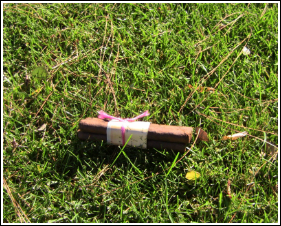 McClellan's copy of the lost order, as examined in the Library of Congress, clearly shows creases where it appears to have been folded for many years into a shape 3" X 5." Three cigars can easily be laid side by side upon the surface of the folded paper and tied by a string. Laid on the ground in this configuration, what Barton Mitchell would have seen is the cigars and, if they looked unspoiled by the weather, how likely would it have been for a reasonable person in his shoes not to stoop to pick them up? The existence of the cigars can reasonably have no other purpose than to function as the means of attracting the Union soldier's attention to the object lying near his feet. There simply can be no other rational explanation: The suggestion that a courier, traveling the short distance from Lee's headquarters camp to D.H. Hill's location, would have connected cigars somehow to the paper he was carrying to Hill smacks of incredibility.
McClellan's copy of the lost order, as examined in the Library of Congress, clearly shows creases where it appears to have been folded for many years into a shape 3" X 5." Three cigars can easily be laid side by side upon the surface of the folded paper and tied by a string. Laid on the ground in this configuration, what Barton Mitchell would have seen is the cigars and, if they looked unspoiled by the weather, how likely would it have been for a reasonable person in his shoes not to stoop to pick them up? The existence of the cigars can reasonably have no other purpose than to function as the means of attracting the Union soldier's attention to the object lying near his feet. There simply can be no other rational explanation: The suggestion that a courier, traveling the short distance from Lee's headquarters camp to D.H. Hill's location, would have connected cigars somehow to the paper he was carrying to Hill smacks of incredibility.
Second, there is the fact that the fields around Frederick were inundated with rain from a storm all day on September 11th, lasting at least into the night. Heros Von Borcke, JEB Stuart's chief of staff at the time, wrote in 1866 of September 11th: "On the morning of the 11th we received marching orders. . . . A steadily falling rain, which gave us some discomfort in the saddle, added much to the dejection of spirits with which we got in readiness to move away from Urbana."[78] According to a Union soldier, "steady rain" fell the evening of the 11th; "The storm stretched from Frederick to Washington."[79] And Alfred Pleasonton, McClellan's cavalry commander is reported as saying, "I entered Frederick (on the 12th) about 5:00 p.m." and "the roads were muddy from the previous day's rain.[80] If one assumes, as all civil war writers have, that the lost order was written and sent by courier to Hill on September 9th, or at the latest the morning of the 10th, the paper and cigars must have been lying in the field where they were found for at least three, if not four, nights and three and a half days. McClellan's copy of the order—as it exists today in the Library of Congress—shows a small splotch on its surface; hardly sufficient evidence to infer the fact that the paper had been exposed to the weather for such a length of time, much less that it had been lying on the grass of a farm field during a twelve hour rain storm.
Magnifying the incredibility of arguing otherwise, is the fact that, on the 12th, the corps of the Union Army pressed Stuart's cavalry divisions back from Sugar Loaf Mountain, on the left of McClellan's advance from Urbana, and back from New Market on the right. The advance guard of the 9th corps, in the early afternoon of the 12th, tramped across the Monocacy on the National Road and skirmished with Stuart's cavalry into the streets of Frederick. These troops went into camp in the fields skirting the suburbs of the town and, by evening, were joined by the divisions of Sumner's corps, which crossed the Monocacy between the Urbana Turnpike and the National Road, and went into camp in the fields adjacent to the Baltimore & Ohio Railroad spur which runs into Frederick on the south side of the National Road.[81] Given the muddy condition of the fields and the tramping of men and horses, the movement of artillery and wagons, it is hardly reasonable to think Lee's lost order could have survived in the condition it now exists. Therefore, the evidence leads to the inescapable conclusion that the order could not have been "lost" in the field until sometime after D.H. Hill's division was long gone from Frederick.[82] Which means necessarily that it was not lost by a courier sent from Lee's headquarters to Hill.
 Blurring the situation is the fact that some thirty years after the event, John M. Bloss published an article in the civil war press in which he claimed that, while lounging on the ground with several of his company, including Mitchell, he saw a “large yellow envelope” in the grass and asked Mitchell to hand it to him. When Mitchell did so, Bloss says he opened the envelope and two cigars and a sheet of paper fell out. Bloss read the paper, recognized its text to be an enemy movement order and carried it to Colgrove.
Blurring the situation is the fact that some thirty years after the event, John M. Bloss published an article in the civil war press in which he claimed that, while lounging on the ground with several of his company, including Mitchell, he saw a “large yellow envelope” in the grass and asked Mitchell to hand it to him. When Mitchell did so, Bloss says he opened the envelope and two cigars and a sheet of paper fell out. Bloss read the paper, recognized its text to be an enemy movement order and carried it to Colgrove.
The civil war writers, ignoring the fact the 27 Indiana’s historian could find no evidence that Bloss’s story had been known by the regiment at the time, seize upon Bloss’s introduction of the “large envelope” to explain away the absence of water damage to McClellan’s copy of the order.[83] But, as the 27th Indiana’s historian observed, the fact Bloss’s story was not common knowledge among the regiment’s survivors leads to the conclusion Bloss manufactured it for personal gain.[84]
More weight on the scales in favor of General Lee’s manipulation of the event, is his documented reaction to news of the order's loss. Stephen Sears has written about this: "Remarkably, there is no record of General Lee or anyone at his headquarters ever investigating the matter, even after, some months later, it was learned that a copy of S.O. 191 had reached enemy hands.[85]
Months later? The indisputable evidence is, by General Lee's own admission, that he was on actual notice, no later than the early morning hours of September 14th, that McClellan had the Lost Order in his hands.[86] Yet, the knowledge of this did not induce General Lee to order his "main body" to flee Maryland and rendezvous with the rest of his army in Virginia. Instead, he sent his trains across the Potomac at Williamsport and marched in plain view of Pleasonton's scouts across the Cumberland Valley to support D.H. Hill's defense of Turner's Gap. The inference from this is obvious: there was nothing to investigate. He had tricked McClellan into thinking, throwing his weight against Crampton's Gap would expose him to an attack from Lee's main body at Turner's Gap, and now Lee had a good chance to draw McClellan into battle at Sharpsburg.[87]
V. Who Wrote McClellan's Copy?
Given the totality of the circumstances shown by the evidence so far, the presumption must be that McClellan's copy was lost no earlier than about noon on September 13th. But who wrote it? In resolving this question, the opinion of a so-called "handwriting expert" is not required. As a federal court has explained,[88] there is a lack of empirical evidence that such an "expert" is any more proficient than a lay person to correctly match handwriting samples, because such opinions constitute "nothing more than a set of subjective observations and little different from an unsupported opinion as to the fact of authorship of a document."[89]
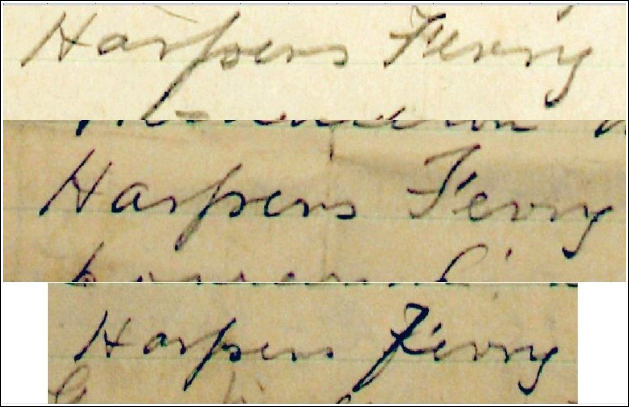
Examples from McClellan’s copy: Note the shape of the “H” and the “y.”
Leaving the matter then to lay persons to decide, the first task is to examine the writings of those most likely to have written the text of McClellan's copy; under the standard theory of the order's accidental loss, these persons would be the members of Lee's personal and attached adjutant general staff; i.e., T.M.R. Talcott, A.L. Long, Walter Taylor, Charles Marshall, Charles Venable, Robert Chilton, and A.P. Mason.[90]
A two-thirds majority of reviewers, who compare the handwriting of these candidates with the writing of McClellan's copy, will probably distinguish the latter example from the former examples easily. Since the handwriting of none of these candidates compare favorably with the writing on McClellan's copy, the search for its authorship must expand to include General Lee and his closest confidants—Stonewall Jackson and JEB Stuart. Stonewall’s handwriting is plainly not a probable match.
As for General Lee, the naysayers will point to the fact that as of September 9th, his hands were injured, presumably making it impossible for him to write.[91] Nonetheless, a comparison of the writing in his 1868 letter to D.H. Hill with the writing in Mac’s copy of Special Order 191, reveals some similarities of writing style: For example, the peculiar writing of the “F” in Harper’s Ferry, along with the shaping of H’s, C’s and the swishing ends to the D’s in Lee's writings, ought to make one hesitate before ruling Lee out. But his is not a strong candidate in comparison.
As for JEB Stuart,[92] according to his chief of staff, Heros Von Borcke, his headquarters on the afternoon of September 11th was located, "about a half mile from [Frederick] at the farm of an old Irishman."[93] On the next day, the 12th, all of Stuart's cavalry, except for the rear guard and Fitz Lee's brigade, which was on an unexplained mission in McClellan's rear, had moved west of Frederick and occupied Braddock's Gap in the Catoctin Mountain range.[94] Stuart himself, in the company of other officers, spent most of day of the 12th in Frederick, at the residence of William R. Ross, a well-known and wealthy lawyer who was pro-South in sympathy. Earlier, during the Confederate army's stay at Frederick, Stuart as well as other Confederate officers had frequented lawyer Ross's house as the following narrative of one of JEB Stuart's aides, W.W. Blackford, illustrates: "In passing through Frederick I called to take leave of my kind friends, the Rosses, at whose house my father lived while studying law in Mr. Ross's office. . . I had called to see them several times since crossing the Potomac. . . (On the 12th) [w]e had a cavalry engagement in the streets. . . One of the ladies at Mr. Ross's at the last moment ran out as we were taking leave under skirmish fire. . . ."[95]
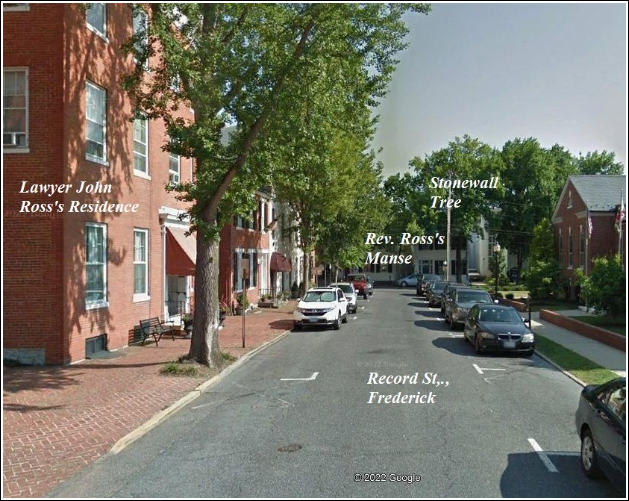
Heros Von Borcke writes of the noon time dinner on the 12th: "General Stuart rode with his staff into Frederick where we had been invited by several prominent citizens to dine."[96] Around 3 o'clock the afternoon of the 12th, after the skirmish with Union cavalry in the Frederick streets, Stuart vacated the place in the company of Von Brocke and went into the Middletown Valley.[97]
Clearly JEB Stuart had the opportunity, after September 10th, to lose McClellan's copy of Lee's order in the field where it was found by Private Mitchell; but he left Frederick too early to leave it in the field, and when examples of Stuart's written messages from the field are compared to McClellan's copy,[98] the writings, though they do not conclusively rule him out, do not appear to match.[99]
If neither General Lee nor J.E.B Stuart wrote the Lost Order, then who could have been the writer? The known circumstances suggest the possibility it could have been General Lee’s eldest son, Custis Lee. In 1905, Dr. Erwin Newton, a member of the staff of the Army Surgeon General, LaFayette Guild, wrote Walter Taylor and said, with respect to the Sharpsburg Campaign, “I recall with pleasure the name of Custis Lee among Lee’s staff.”[100] The statement implies that Newton saw Custis at Frederick. During the war Custis Lee wrote a 300-page manuscript about the life of General Lee’s father, “Light Horse Harry” Lee. The manuscript is now at the Virginia Historical Society, in Richmond. All of the pages show the Platner & Porter Manufacturing Co.’s stationers stamp, as does the Lost Order. Custis was a member of President Davis’s entourage. When Davis began his trip toward Maryland, someone carried ahead of him his letter to General Lee, announcing his coming. The letter arrived on September 9th, and Lee chose Walter Taylor to carry his reply back to Davis. Did Custis deliver Davis’s letter to Lee? Was he present with his father at Frederick? Did he supply the paper stock used to write the Lost Order? Does his authenticated handwriting, examples created at or near the 9th, show a probable match? The Virginia Historical Society does not allow Custis’s manuscript pages to be copied, so they are unavailable here.
Other circumstances provide clues to the timing of the order’s creation, and the manner of its use. First, the writer of McClellan's copy, in writing the September date of the order, wrote first the number "1," not the number "9." He then corrected the date, not by using an eraser, but by interlining. Next to the marked over number "1," the writer then wrote the number "9." This suggests that the text of McClellan's copy was written sometime after September 9th, probably very early on the 10th. Second, side by side comparison of the copy Marshall made and labeled 190, and Chilton's letterbook copy (written in A.P. Mason's hand) with D.H. Hill's copy (written in Jackson's hand) and McClellan's copy, show that McClellan's copy was copied from Jackson's. The former two copies use the same phrase "in intercepting the retreat" in paragraph six; the latter two copies use the same phrase "and intercept the retreat" in paragraph six. Either the writer copied McClellan's copy from Jackson's, or Jackson copied his from the writer’s.

Chilton Letter book in hand of A.P. Mason, copied from Marshall’s copy

McClellan’s Copy in Unknown Hand, copied from Jackson’s copy
Last, of all the known messages, letters, and orders that came out of Lee's headquarters during the Antietam campaign, none of them contain the stationer's embossed stamp that is found in the upper left hand corner of McClellan's copy. Therefore, the paper the writer used probably did not come from Lee’s headquarters stock.
The stationer's embossed stamp identifies the paper of McClellan's copy as manufactured by the Platner & Porter Manufacturing Co. of Farmington, Connecticut. This company was in business manufacturing such paper from 1848 to about 1880.[101] According to Jesse R. Lankford, Jr, North Carolina's State Archivist, this paper was routinely used by North Carolina's civil war government and reams of it can be found in the state archives. At the Virginia Historical Society, in Richmond, Virginia, several hundred pages of this paper can be found, comprising an original manuscript written by General Lee's eldest son, Custis Lee, and published in 1867.[102] And Platner & Porter paper was used by Walt Whitman in his 1862 notebook as he followed the Union Army to Antietam.[103]
From the totality of the circumstances shown by the evidence, then, reasonable minds in the trial court can certainly find the more convincing evidence of the case, points to General Lee, probably in cooperation with Stonewall Jackson, orchestrating the “loss” of the order. But how to do it?
What the record shows is this: Sitting at the camp table in either Stonewall’s tent, of his, General Lee conferred with Jackson for some hours to craft the text of an order which describes the movement of the divisions of the Confederate army, some of which were to march west from Frederick, under Jackson’s command, cross the river at Sharpsburg, march to Martinsburg, capture whatever enemy force was found there, and then march back across river to unite with divisions, under Longstreet’s command, at Boonesboro, while two divisions, under the command of McLaws and R.H. Anderson, marched up to the left bank of the Potomac opposite the Ferry and shelled the place. A division, under the command of John Walker, was to approach the mouth of the Shenandoah River to block the garrison’s line of retreat east.
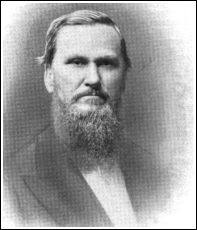 What emerged from the collaborative effort of the two generals, is the first draft of the order written in Stonewall Jackson’s hand. At some point in time, either while they were together, or some time later, Stonewall gave the draft he had written to his adjutant, Robert Dabney, and Dabney copied it and returned it to Stonewall, who gave Dabney’s copy to General Lee.
What emerged from the collaborative effort of the two generals, is the first draft of the order written in Stonewall Jackson’s hand. At some point in time, either while they were together, or some time later, Stonewall gave the draft he had written to his adjutant, Robert Dabney, and Dabney copied it and returned it to Stonewall, who gave Dabney’s copy to General Lee.
Sometime between their conference on September 7, 1862 and September 10, General Lee gave Stonewall's copy to Charles Marshall, with instruction to make a copy. Marshall made the copy in his own hand, labeling it “Special Order 190,” and returned both copies to Lee.[104] General Lee then caused Assistant Adjutant General Robert Chilton to sign Marshall’s copy, and had Chilton’s aide, A.P. Mason, copy the text into Chilton’s letter book. In doing so, Mason added the text of Marshall’s copy to the text of an order he had previously written into the letter book as “Special Order 191. Mason returned Marshall’s copy to General Lee who sent it to President Davis, with a cover letter, on September 13 from Hagerstown.
VI. Who Delivered the Order to Barton Mitchell?
Finally, there is the question of how the lost order was dropped in the field where it was found. Stephen W. Sears, in his supposed last word on the subject, takes the position that the discovery of Special Order 191 "represented the workings of pure chance"—that the order and the cigars "could just as easily have been overlooked as it lay in that clover field." From this logic Sears argues that the order's finding was as much an accident as its loss.[105] An alternative, though, that Sears's logic equally suggests, is that the order had to be lost under circumstances which guaranteed it would be found.
Since Stuart was forced from Frederick the afternoon of the 12th it hardly would have seemed certain to him that his dropping of the order would result in its being found by noon on the 13th.[106] From the point of view of a person in his shoes, the idea of dropping the order to the ground in the face of the oncoming horde of Reno's soldiers, horses, cattle, wagons and artillery, would be silly. There was only one sure way of guaranteeing that the dropping of the order would be discovered and that was to drop it in the presence of the soldiers who were to find it.
Who the person was by which this was done the evidence does not exactly say. But that a civilian could easily have planted it in the vicinity of Barton Mitchell stacking his arms the evidence does say: for, "[t]he town jubilantly welcomed the liberators. `Handkerchiefs are waved, flags are thrown from Union houses, and a new life infused into the people,'. . . The troops responded with volleys of cheering, and regimental bands blared martial music. . . `the place was alive with girls going around the streets in squads waving flags, singing songs and inviting the soldiers in for hot supper. . . [T]he next day (the 13th) the people began to cook for us, bringing out as we passed, cake, pie and bread.' . . . It was like a gigantic Fourth of July celebration. . . ."[107] And, in the excitement, someone walked by Mitchell and let fall from his, or her hand the folded paper of the order wrapped around cigars.
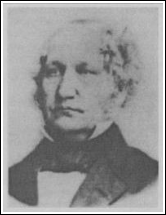 If the issue of this had been raised at the time, a prime suspect might well have been the Reverend Doctor, John B. Ross and his wife, Mary McDowell Ross, Charles Venable’s sister-in-law. In 1854, Dr. Ross married Mary McDowell, and about that time Venable married her sister, Margaret. At this time, Dr. Ross was the pastor of a church in Lexington, Virginia and was a personal friend of Jackson, the two men praying together in Ross’s home. In 1856, Dr. Ross became pastor of the Frederick First Presbyterian Church. Dr. Ross’s Manse is located just a few doors down the street from Lawyer’s Ross’s residence which Lee, Jackson, Stuart and others spent time at during the army’s occupation of Frederick. It would have been a simple matter for Charles Venable to carry Dabney’s copy of the order down the street in the night, enter the Manse and gain the minister’s agreement to drop the order in the field.
If the issue of this had been raised at the time, a prime suspect might well have been the Reverend Doctor, John B. Ross and his wife, Mary McDowell Ross, Charles Venable’s sister-in-law. In 1854, Dr. Ross married Mary McDowell, and about that time Venable married her sister, Margaret. At this time, Dr. Ross was the pastor of a church in Lexington, Virginia and was a personal friend of Jackson, the two men praying together in Ross’s home. In 1856, Dr. Ross became pastor of the Frederick First Presbyterian Church. Dr. Ross’s Manse is located just a few doors down the street from Lawyer’s Ross’s residence which Lee, Jackson, Stuart and others spent time at during the army’s occupation of Frederick. It would have been a simple matter for Charles Venable to carry Dabney’s copy of the order down the street in the night, enter the Manse and gain the minister’s agreement to drop the order in the field.
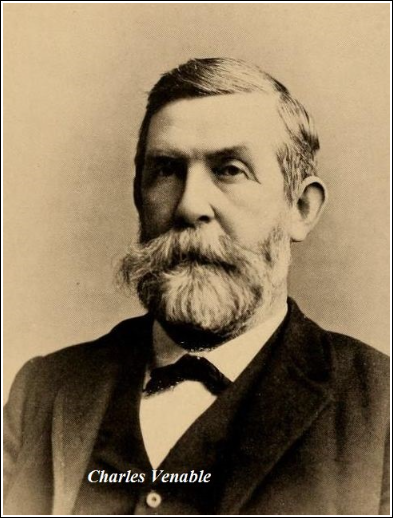
The Probable Go-Between
According to Henry Kyd Douglas, one of Jackson's aides, Jackson appeared at the church Manse the morning of September 10th.[108] In a manuscript the UNC Press used to publish I Rode With Stonewall, in 1940, Douglas had written—"The General was anxious, before leaving Frederick, to see the Reverend Dr. Ross, a personal friend, and I took him to the house."[109] As the church's historians have reported it, during September 1862 "Rev. Ross was visited by his personal friend, Stonewall Jackson."[110] The event does appear to have happened, as there is proof that Jackson did, in fact, leave a terse hand-written message with a servant man to deliver to the Rosses, Jackson ostensibly unwilling to rouse the house at 6:00 a.m. as he was leaving town.[111] In addition, there is the tradition among the townspeople that Jackson tied his horse to the tree in front of the Manse. But, to a trial lawyer, the Jackson “visit” seems plainly an effort to impress the townspeople that the Rosses did not actually meet personally with Confederates, though everyone knew they were Virginians, that Mrs. Ross was the daughter of an ex-Virginia Governor. Notwithstanding the effort at deception, shortly after the battle of Antietam, at a congregation meeting, Dr. Ross resigned his position as pastor and, with his wife and daughter, left Frederick.[112]
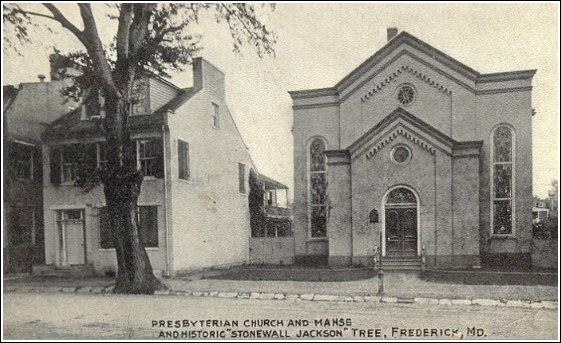
Whether Charles Venable delivered the lost order to the Ross residence, without more objective evidence, the answer cannot be positively known. Notwithstanding this, however, what can nonetheless be reasonably inferred from the totality of the circumstances is that either Dr. Ross, or his wife Mary McDowell, strolled across the field near where Barton Mitchell was stacking arms and dropped the order in the grass.
The probability of this is established by the fact that Charles Venable was married to Mrs. Ross’s sister. This fact is too much a coincidence to bear, and remain blind to the reality: not only did Dr. Ross have a personal relationship with Jackson but Ross’s wife’s sister was married to General Lee’s chief of staff, Charles Venable. One must be a very credulous person not to recognize the likelihood it was Venable who used his sister-in-law to deliver the order to Mitchell.[113]
Not only is it more probable than not, that Venable was the go-between, when the totality of the known circumstances of the case are summed up, Charles Venable looms largest amongst Lee’s HQ staff as the most knowledgeable witness to be examined in court. During his life time, Venable wrote some eighty pages of text he titled “Personal Memoirs of the Confederate War.” The unpublished manuscript is dated 1889. Venable died in 1900 at Charlottesville. In it, at pages 60-61, Venable wrote this:
| “The order, a dictation by General Lee, was copied carefully in the Adjutant’s tent by Colonel Taylor’s aide and brother in the camp at Frederick and sent out to generals of divisions by Colonel Taylor.” |
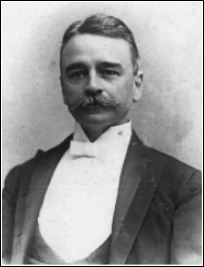 Dissecting Venable’s sentence, he first tells us that what was copied by “Colonel Taylor’s aide and brother” was a document that General Lee had dictated to a person Venable does not identify. From the totality of circumstances shown by the evidence, however, we can reasonably conclude that person was Jackson. So, we now have General Lee handing to Colonel Taylor’s aide and brother the draft Jackson had made at Lee’s dictation, and the brother copied it. But, here, Venable’s story is contradicted by the fact that, on September 9, Taylor was sent away from the army to Virginia, and in his two books, published in 1878 and 1906, Taylor does not reveal he possessed any personal knowledge of who was involved in either the copying the order, or in its transmittal. Yet, Taylor had several brothers, one of whom was named Richard C. Taylor, and he was a member of the 6th Virginia Regiment of Mahone’s brigade of Anderson’s division and was likely with the regiment at Frederick in September 1862. Why would Venable identify “Taylor’s brother” as a copier of the draft order, if he did not know, from personal knowledge, this was the fact? Both Taylors were alive as late as 1916, and, had he published his memoirs with this statement, Venable could expect to hear complaints if the statement was untrue.
Dissecting Venable’s sentence, he first tells us that what was copied by “Colonel Taylor’s aide and brother” was a document that General Lee had dictated to a person Venable does not identify. From the totality of circumstances shown by the evidence, however, we can reasonably conclude that person was Jackson. So, we now have General Lee handing to Colonel Taylor’s aide and brother the draft Jackson had made at Lee’s dictation, and the brother copied it. But, here, Venable’s story is contradicted by the fact that, on September 9, Taylor was sent away from the army to Virginia, and in his two books, published in 1878 and 1906, Taylor does not reveal he possessed any personal knowledge of who was involved in either the copying the order, or in its transmittal. Yet, Taylor had several brothers, one of whom was named Richard C. Taylor, and he was a member of the 6th Virginia Regiment of Mahone’s brigade of Anderson’s division and was likely with the regiment at Frederick in September 1862. Why would Venable identify “Taylor’s brother” as a copier of the draft order, if he did not know, from personal knowledge, this was the fact? Both Taylors were alive as late as 1916, and, had he published his memoirs with this statement, Venable could expect to hear complaints if the statement was untrue.
Taking Venable at his word, the scenario might well have been that, first, Lee and Jackson together came up with the text of the order─ Jackson, in lee’s presence, writing out the details in his own hand. Second, Lee gave Jackson’s draft to Richard Taylor, after his brother Walter was gone from the camp, and told him to make a copy, instructing him to write “For D.H. Hill” at the bottom. Third, Lee took back both Jackson’s draft and Taylor’s copy. Fourth, Lee then gave Jackson’s draft to Charles Marshall and told him to make a copy. In doing so, Marshall changed the syntax of the “intercept the enemy” line in the Walker paragraph. Fifth, Lee caused Marshall’s copy, labeled “Special Order 190,” to be copied by A.P. Mason into Chilton’s letter book, and then, while he was at Hagerstown, he sent Marshall’s copy, with a letter, to President Davis on September 12, 1862. Last, Lee gave Venable Taylor’s copy and Venable delivered it to his sister-in-law, Mrs. Ross, while Jackson gave his draft to his brother-in-law, D.H. Hill
Conclusion
Did General Lee intentionally lose his order, or was it an accident as the historians and civil war writers say? To answer the question, one must rely on the evidence which has more convincing force than that opposed to it. Here, the tactical realities of the ground, the unsworn testimony of those witnesses most knowledgeable about the promulgation of orders, the circumstances of the weather and the cigars, and the reasonable inferences to be drawn from them, much less the problem of identifying the handwriting on McClellan's copy, all converge to point to the finding of intent as the probable truth.
While discrepancies do exist in the facts, they can be reasonably reconciled in light of the totality of the known circumstances. First, because the eight paragraph version of Special Order 191 was misnumbered 190 by Marshall, Robert Chilton, when he signed it, would not necessarily have corrected it, since the order he signed authorizing Walter Taylor to leave the army was numbered 191. Second, as originally written, order 191 was, in fact, a "special" order as defined by Confederate Regulations, because it dealt solely with the specific detachment of Taylor from the army. In contrast, the order numbered 190, which Marshall wrote and Chilton signed, was by its terms a "general" order since it dealt with the movement of the entire army.
Someone presented this general order to A.P. Mason to copy into Chilton's letter book; in doing so, Mason was confronted with the fact that, on September 8th, he had previously copied into the letter book a four paragraph order labeled "Special Order 190" which authorized leaves of absences for four disabled officers.[114] Whether on his own initiative, or by instruction from someone, the fact is that Mason added the text of Special Order 190, as written by Marshall, to the text of Taylor's detachment order labeled 191.
Years later, when Davis queried Chilton about how the order was issued at Frederick, Chilton remembered what a reasonable person would probably have remembered—a special order was sent by courier to a commander on detached duty, and since the name of D.H. Hill was known to be recorded on McClellan's copy of Order 191, Chilton assumed the courier had been sent to Hill; when, in fact, the courier had been sent to Walker on the Monocacy.

McClellan’s Copy would be the only one with cc to Hill

Chilton’s actual signature
Last, it is obvious that the credibility of the key members of General Lee's personal staff is highly suspect. In 1878, Walter Taylor was the first to write publicly about the incident of the lost order. Taylor, of course, could have had no personal knowledge about the issuance of the lost order, because he had been sent to Virginia by General Lee and did not return to Maryland until the army had already reached Sharpsburg. To explain the loss of the order in his book, Taylor invoked a supposed statement of Charles Venable's; by writing—"Colonel Venable. . . says in regard to this matter: 'This is easily explained. One copy was sent directly to Hill from headquarters. General Jackson sent him a copy.'" Eight years later, in his book, Memoirs of General Lee, A.L. Long repeated verbatim Taylor's quotation of what Venable supposedly said. Clearly, by their reliance on a hearsay statement (in Long's case, double hearsay), it is obvious that both Taylor and Long did not know from personal knowledge that a copy of order 191 was actually sent to Hill "from headquarters." But Taylor thought Venable knew. Yet, inexplicitly, Charles Venable, who lived a long time after the war, never made a public or private statement about his actual knowledge of the matter, even though he knew Taylor and Long had invoked his name as the one living witness who claimed a copy of the order was sent to Hill from headquarters.[115]
What about Charles Marshall? He never disclosed to anyone what he knew of the order being sent to Hill. Both he and Venable wrote unpublished narratives of their experiences as Lee's staff officers, yet both men wrote nothing which explained their involvement in the handling of the order. These facts damage the credibility of Taylor's hearsay statement greatly, because the inference follows reasonably from the fact of their silence that neither man could bring himself to come forward with an account of his actual knowledge. Given the undisputed facts of the case, the reason for this failure is obvious: they knew enough to know that, in bringing on the battle of Antietam, General Lee had probably used the order as a ruse of war.
They had good reason to keep their mouths shut. In 1876, two years before Taylor's Four Years with General Lee was published, Louis Phillipe d'Orleans, known as the Comte de Paris, published the second volume of his work, History of the Civil War in America. In it he expressed the prevailing public view that the Battle of Antietam "was a defeat for the Confederates in the triple view, of tactics, strategy, and politics. . . Th[e] error was in [Lee's] dividing his forces to capture Harper's Ferry. Had he not done so he could have fought upon South Mountain or continued the campaign on the upper Potomac. . . so much blood shed to no purpose for the Confederate cause."[116]
d'Orleans's 1876 view was shared by Major General Frederick Maurice, in 1925, when his book Lee the Soldier was published. "I have condemned Lee's decision to fight behind the Antietam," Maurice said, "because no general should fight a battle which is not forced upon him unless the chances of obtaining decisive results preponderate in his favor."[117] Another important British war theorist, J.F.C. Fuller, echoed this view when he wrote, in 1933: "The battle of Sharpsburg was a totally unnecessary battle."[118] In the face of such criticism, from Marshall's and Venable's points of view, how worse would the public perception be of Lee, if they had made known that he intentionally used a ruse to draw McClellan into the battle? So they kept quiet about their knowledge of the order, although Marshall was quick to challenge the assumption that the battle was not "forced" on General Lee.
Writing to the Comte de Paris, in 1877, Marshall made the persuasive argument that, after the Union army's defeat at Bull Run, General Lee had to fight somewhere: "The country around [Bull Run] within a compass of fifty miles had been stripped by both sides, and was wholly incapable of supporting an army. What was General Lee to do?" He wrote. "His army could not be maintained where it was. . . it was not possible to make a direct attack upon Washington. . . if he were [to retreat] it would be taken as an admission. . . that he had no policy but to await such attacks as the Federals might make."[119] Therefore there was nothing left for General Lee to do but move indirectly toward the Shenandoah Valley, by moving through Maryland.
The Shenandoah Valley was the only place left in Northern Virginia where Lee's army could live off the land for an extended period of time. But it could not be reached safely by marching directly to it. The movement would be recognized by the enemy as a retreat and it would have left roads to Richmond undefended. And General Lee needed to use the Valley as a sanctuary, not a battleground, for his troops. Thus, General Lee had no reasonable choice but to retreat, unless he might keep up the pretense of threatening an offensive against Washington by marching the remnant of his army to Frederick. Once there a battle had to be planned which carried with it the reasonable probability that the enemy's capacity for combat might be weakened enough to make him stop fighting—at least long enough for the Confederate Army to replenish its strength for the offensive again.
Above all else, battles are tests of military structure; the object is not merely to kill but to disorganize. As Clausewitz has written, "Getting the better of the enemy—that is, placing him in position where he has to break off the engagement—cannot in itself be considered as an objective. Nothing remains, therefore, but the direct profit gained in the process of destruction. This gain includes not merely casualties inflicted during the action (which many times will be equal), but also those which occur as a direct result of the retreat . . . The really crippling losses, those the vanquished does not share with the victor, only start with his retreat. . . Thus a victory usually only starts to gather weight after the issue has already been decided."[120] Lee denied McClellan the real profit of battle by the fierce tenacity of his defense, which wrecked the Union Army's organization and stopped it cold, freezing McClellan at the Potomac while he retreated unmolested into the haven of the Shenandoah Valley.
Dwight D. Eisenhower, in writing of the risk he took in leaving the Allied front through the Ardennes forest weakly defended, in 1944, said this: "At any moment from November 1 [1944] onward I could have passed to the defensive along the whole front and made our lines absolutely secure from attack while we waited for reinforcements. . . We remained on the offensive and weakened ourselves where necessary to maintain those offensives. This plan gave the German opportunity to launch his attack; if giving him the chance is to be condemned by historians, their condemnation should be directed at me alone."[121]
Like General Eisenhower, in giving the enemy the chance, General Lee took a calculated risk that resulted in the sacrifice of the lives of thousands of young Americans. In both cases, the sacrifice reaped for the American commander a great battle profit—in Eisenhower's case the ultimate overwhelming of the German resistance at the Siegfried Line; in Lee's, the time to replenish his army’s strength to remain on the offensive deep into 1863. With the lost order General Lee' gave his country, his government, his people two more years of existence in the East, and the risk he took with it marks him among the greatest of America's soldiers.
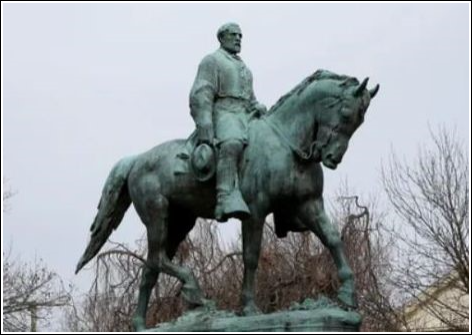
General Lee Leading the Young Americans to the Antietam
| * * * |
Show Notes
| * * * |
© 2026 Joseph Ryan
Published online: 07/30/2022.
Written by Joseph Ryan.
Joseph J. Ryan is a Los Angeles trial lawyer who has traveled the route of the Army of Northern Virginia, from Richmond to Gettysburg many times. He has written a book entitled Rebellion Roads, the narrative covering the Peninsular and Sharpsburg campaigns.
* Views expressed by contributors are their own and do not necessarily represent those of MilitaryHistoryOnline.com.




